Mount Jiuhua, located at Qingyang County, Chizhou City of Anhui Province, is one of the four sacred Buddhist mountains in China, together with Mount Wutai in Shanxi, Mount Putuo in Zhejiang and Mount Emei in Sichuan. Mount Jiuhua is dedicated to Ksitigarbha (Chinese Pinyin: Dizang), a bodhisattva and protector of beings in hell realms according to Mahayana Buddhist tradition. This holy land is listed as “National AAAAA Tourist Attraction” and reputed as “Buddhist Heaven for Lotus Flowers”.
Traveling to Mount Jiuhua can not only immerse in the breathtaking natural beauty, but also have deep understanding about Chinese Buddhism and Mount Jiuhua's profound culture.
Historical & Cultural Mountain. Mount Jiuhua originally called Mount Jiuzi in Liang and Chen Dynasties in Song Dynasties. A legend says that the famous poet Li Bai in Tang Dynasty came to Mount Jiuhua several times, when he saw the shape of 99 peaks like a blossom lotus and wrote down the poem “Magic is divided into two branches, sacred mountain generates nine glories” (妙有分二气,灵山开九华). Hence, Mount Jiuzi changed into Mount Jiuhua which has been using till today. After Li Bai, there were numerous scholars, poets and litterateurs came and left great works. Even, the emperor Kangxi in Qing Dynasty inscribed “Holy Land of Mount Jiuhua” (九华圣境). Travelers can enjoy the stories from ancient academies and other historical sites.
Buddhist Holy Land with over 1600 Years. “A mountain is not famous for its height but for its holiness”. In 401 AD in Eastern Jin Dynasty, the monk “Beidu” from old India came to Mount Jiuhua to build temples and preach Buddhism. In 719 AD, Kim Qiaoque, a Silla (today's South Korea) prince came to Jiuhua Mountain and cultivated himself for 75 years. He died at 99 years old and his corporeal body stayed intact. Because he was very similar in appearance to Ksitigarbha Bodhisattva, the monks here believed Ksitigarbha Bodhisattva was reincarnated in him. Hence, Mount Jiuhua became the place to hold rites for Ksitigarbha Bodhisattva.
Breathtaking Natural Scenery with 99 peaks. Jiuhua Mountain is reputed as “the First Mountain in Southeast China” with magnificent peaks, murdering streams, bizarre rocks, beautiful waterfalls, seclude caves, etc. Among the 99 peaks, nine famous ones are outstanding, including Tiantai Peak, Tianwang Peak, Shiwang Peak, Lianhua Peak, Duxiu Peak, Luohan Peak, Wulao Peak, Fuhu Peak and Furong Peak. And the main streams include Jiuhua Stream, Qingtong Stream, Laba Stream, Dragon Stream, Jiuzi Stream, Wulong Stream, etc. Travelers can immerse yourselves with intoxication in “Ten Scenes of Mount Jiuhua” and “Ten New Scenes of Mount Jiuhua”.
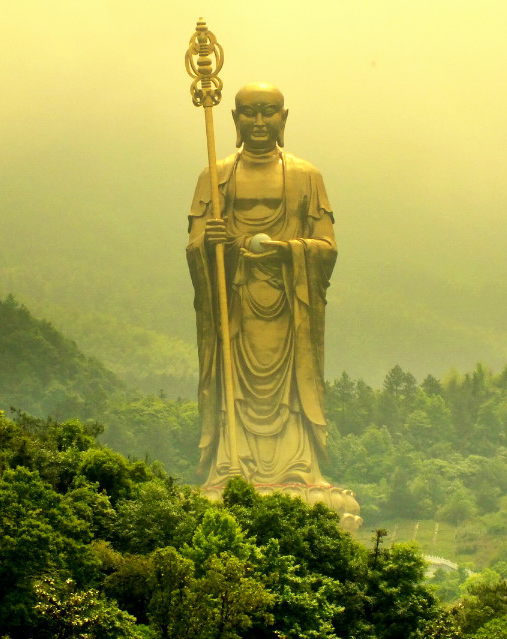 99-meter Statue of Ksitigarbha Bodhisattva
99-meter Statue of Ksitigarbha Bodhisattva
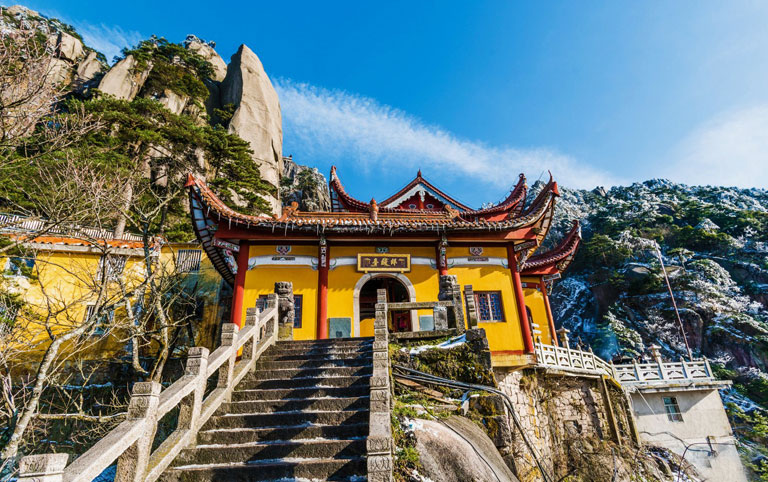 Gorgeous View of Mount Jiuhua
Gorgeous View of Mount Jiuhua
There are many scenic areas in Mount Jiuhua, but the most frequently-visited are 4 main scenic areas (Jiuhua Street Scenic Area, Heavenly Scenic Area, Flower Scenic Area, Minyuan Scenic Area) and Great Vow Culture Park.
Jiuhua Street Scenic Area is the core scenic area, and it can be reached by a sightseeing bus from Jiuhuashan Tourist Center in Kecun Village. With so many significant temples located, Jiuhua Street Scenic Area shows you the most cultural highlights of Mount Jiuhua, including Longevity Palace, Incarnation Grand Hall, Huacheng Temple, Zhiyuan Temple and Yitan Forest, Dongya Buddhist Temple, etc. If you are a Buddhist pilgrimage, remember to stay longer in this scenic area. Besides its cultural status, it also acted as a tourist distribution where you can find most stores and hotels. There are available sightseeing buses from Songxianqiao Station in Jiuhua Street to Jiuhuashan Tourist Center in Kecun Village.
Heavenly Terrace Scenic Area is another must-be-visited area of Mount Jiuhua. Both natural and cultural sights can be appreciated in this scenic area. Tiantai Temple (alt: 1306m ), located in the Tiantai Peak (also translated as Heavenly Terrace Temple), is the highest temple of Mount Jiuhua. It is believed that Ksitigarbha Bodhisattva once accommodated in the temple. Besides, there are many other worth-visiting attractions scattered from the foot to the summit of Tiantai Peak, such as Ancient Lecture Temple, Huiju Temple and various kinds of Buddhist Nun Communities… Shiwang Peak, the highest peak of the whole mountain, is also located in Heavenly Terrace Scenic Area.
Having typical features of granite terrain, Flower Terrace Scenic Area has the most magnificent and beautiful natural landscape and is regarded as the most beautiful place in Jiuhua Mountain. If you are a nature lover or shutterbug, don't miss Flower Terrace Scenic Area. There is no temple in Flower Terrace, but it has peaks with different posture everywhere. Since the road is quite dangerous and it needs 5-6 hours to hike the mountain, taking caber way is a great choice to save your energy and time. Recommended sights of Flower Terrace Scenic Area are Tianzhu Peak, Luohan Peak, Ksitigarbha Well, ksitigarbha Boots, Manjusri Cave, etc.
Minyuan Scenic Area combines the lower parts of Heavenly Terrace Scenic Area and Flower Terrace Scenic Area. It can be visited by walking leisurely. The top tourist spots of Minyuan Scenic Area contains Minyuan Bamboo Forest, Phoenix Old Pines, Dragon Stream, etc.
Great Vow Culture Park is located at the foot of Jiuhua Mountain, and the main highlights of it is 99-meter Kssitigarbha Bodhisattva Statue which is also the symbol of Mount Jiuhua. For Buddhist followers and pilgrims, it is necessary to pay homage to this great statue.
In the five scenic areas of Mount Jiuhua, you really get a lot of attractions to visit. Here we list the most popular attractions where you can have a better understanding of Buddhism or feast your eyes on the spectacular natural landscape.
With about 1300 years' history, the Incarnation Grand Hall is the burying place for Ksitigarbha Bodhisattva - Kim Qiaojue. Hence, the Incarnation Hall is also called Ksitigarbha Pagoda. The hall is built on a high terrace with stone pillars, red wall, iron tile, white marble and “The First Mountain in Southeast China” (东南第一山) inscribed on the front door. In the Hall, travelers can view the seven-story wooden Ksitigarbha Pagoda with white marble base. Inside the pagoda, you can worship the Ksitigarbha Bodhisattva with over 100 statues which is magnificent and solemn.
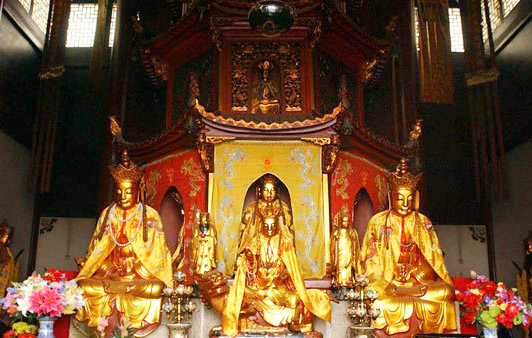 The Incarnation Grand Hall
The Incarnation Grand Hall
Standing at 871 meters, the Longevity Palace was first in Ming Dynasty, listed as one of the Four Buddhist Temple of Mount Jiuhua. The palace is five-story old castle without separate buildings. The castle-like palace is composed of front gate, grand hall, fresh-body hall, vegetarian restaurant, etc. The palace is enshrined with the fresh-body of Wuxia master. In the 16th century, the monk called Wuxia after traveling to Mount Wutai and Mount Emei came to Mount Jiuhua and cultivated himself and live till 126 years old. His corporeal body was found three years later after he died which was without decomposition. Hence, the temple changed into Longevity Palace. The emperor Congzhen in Ming Dynasty granted Wuxia as “Yingshen Bodhisattva” (应身菩萨).
Close to the Longevity Palace is Hall with 500 Arhat Statues (五百罗汉堂) in the style of palace structure. There are 500 grand Arhat Statues with different expression and gestures enshrined in the hall. The Hall of 500 Arhat Statues is only kept in Mount Jiuhua among the Four Sacred Buddhist Mountains.
When you reach the viewing deck of Longevity Palace, you can turn east to have a grand view of the mountains in the shape of natural Sleeping Buddha sitting on the ground. The sleeping Buddha is located at Flower Terrace Scenic Area with its head towards Heavenly Terrace peaks, its neck and nose composed by Big Flower Terrace. It is very vivid, holy and mysterious!
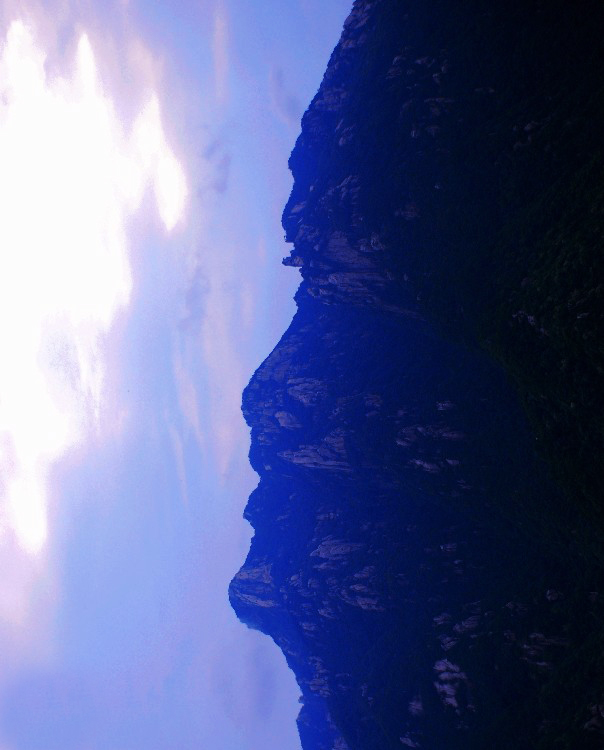 Sleeping Buddha over Longevity Palace
Sleeping Buddha over Longevity Palace
According to Buddhist Scripture, there is a saying “pointing an area as a city”. This temple is located at the center area of Huacheng basin and got the name “Huacheng Temple”. It is the rite for Ksitigarbha Bodhisattva with long history. In Eastern Jin Dynasty (401 AD), the monk Beidu built the temple for cultivation. Rebuilt in Tang Dynasty, when Kim Qiaojue came to Mount Jiuhua and died at 99 years old, Huacheng Temple was regarded as the rite for Ksitigarbha Bodhisattva. Visiting Huacheng Temple, travelers can first have a good look at the pair of stone lions which was the relics from Tang Dynasty, walk up the stairs with three huge doors inscribed with couplets to describe as the first temple among all the temples of Mount Jiuhua. Walking into the front gate, you can see the Depository of Buddhist Sutras, the Great Buddha's Hall, Old Bronze Bell, etc. You can also take a view at the important cultural relics, like palm-leaf manuscript, Tripitaka, Sakyamuni Bronze Statue at 1.98 meter high, Sakyamuni Jade Sitting Statue at 0.74 meters high, etc.
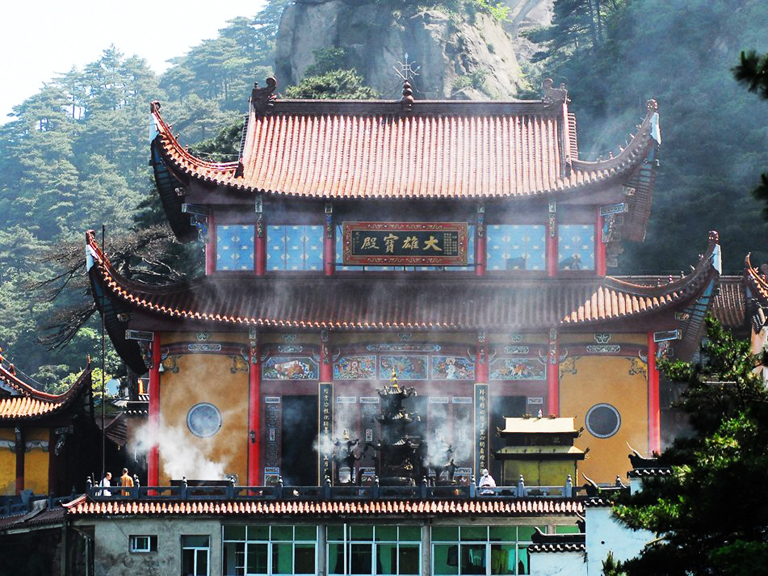 The Great Buddha's Hall of Huacheng Temple
The Great Buddha's Hall of Huacheng Temple
Located at the entrance of Jiuhua Street, Zhiyuan Temple, first built in Ming Dynasty, is listed as one of the Four Buddhist Temples of Mount Jiuhua. This temple is composed of nine separate buildings - Linggong Palace, Maitreya Palace, the Great Buddha's Hall, Bright Lecture Hall, etc. All the structures are exquisite. Inside the Great Buddha's Hall, travelers can see the 12-meter-high Buddhas - Sakyamuni Buddha, Amitabha Buddha and Bhaisajyaguru Buddha, moreover, you can see Manjusri Buddha, Samantabhadra Bodhisattva, the Eighteen Arhats' sitting statues. In the Depository of Buddhist Sutras, there is the precious “Tripitaka” (Qianlong Version), the only tripitaka in Chinese engraved by the official in Qing Dynasty. Walking around the temple, you can view a huge bronze cooking pot which can be used as cook for 1000 monks. If time permits, you can get up early to Zhiyuan Temple to catch the beautiful and misty morning glow.
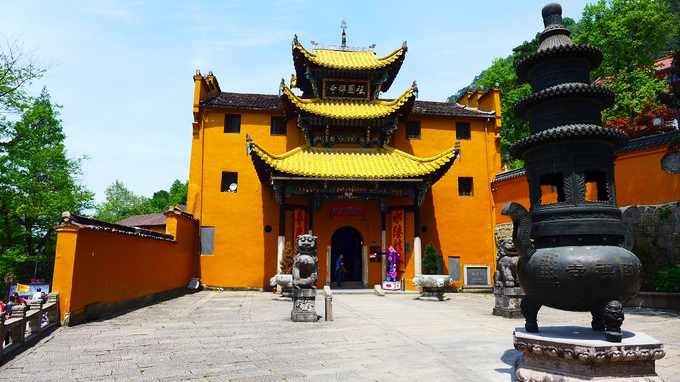 Zhiyuan Temple
Zhiyuan Temple
Tiantai Peak, also called Heavenly Terrace Peak, is standing at a height of 1306 meters. It is a little lower than Shiwang Peak at 1342 meters. A saying goes “you never reach Mount Jiuhua without a visit to Heavenly Terrace Peak”. Numerous believers and travelers head to Heavenly Terrace Peak and pray at Tiantai Temple. This place they believed is the half-way world linking with sky and earth.
Heavenly Terrace Peak is the best site to enjoy the panoramic view of Mount Jiuhua as well as catch the sunrise over Mount Jiuhua and the scene of “Tiantai Sunrise” is listed as one of the ten scenes of Mount Jiuhua. To catch the holy sunrise, you'd get to Pengri Pavilion and Cloud Gorge at the right time.
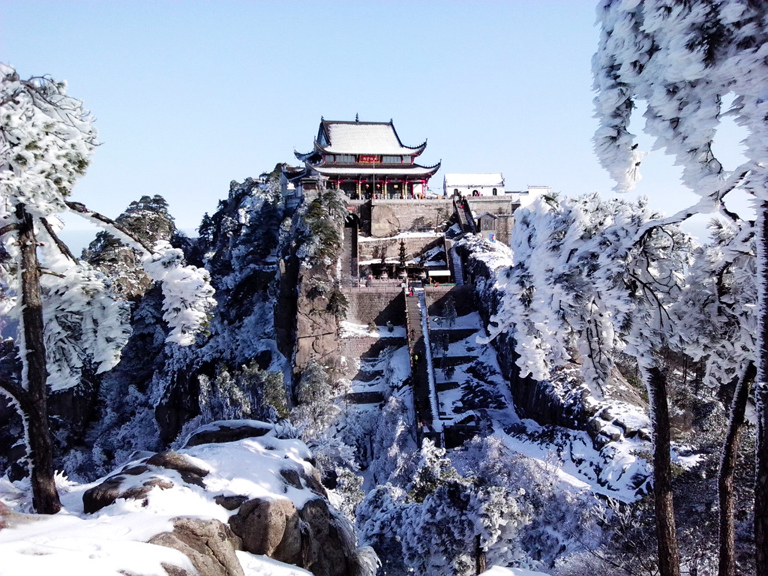 Tiantai Temple on the top of Tiantai Peak
Tiantai Temple on the top of Tiantai Peak
Traveling Mount Jiuhua, you also get some special experience, namely pilgrimage and hiking.
Mount Jiuhua, as one of the most sacred Buddhist mountain with so many Buddhist sights and stories, is a wonderful place in explore Chinese Buddhism. No matter you are a Buddhist follower, or a traveler interested in Buddhism, you can get a better understanding of Chinese Buddhism. To better enjoy a Buddhism tour, we suggest you add the most important Buddhist sites – 99-meter Ksitigarbha Bodhisattva Statue, Ancient Lecture Temple, Longevity Palace, Incarnation Grand Hall and Tiantai Temple into your itinerary.
If you want to attend some Buddhist activities during your trip, you can seize the right time to travel to Mount Jiuhua, such as:
Bathing Buddha Fair (the 8th day of the 4th Lunar Month): It is an important fair to celebrate the birthday of Sakyamuni, also the most important festival in Chinese Buddhism. The Buddhists will take a holy bath of a statue of baby Sakyamuni.
Jiuhua Temple Fair (the 30th day of the 7th Lunar Month): It starts from the birthday of Bodhisatva Kshitigarbha and lasts 7 days usually. The monks will chant sutras day and night in The Incarnation Grand Hall.
Yulan Fair (the 15th day of the 7th Lunar Month): It is also called Ghost Festival. All the temples in Jiuhua Mountain will chant The Ullambana Sutra to expiate the sins of the dead.
Land and Water Buddhist Ceremony (the 7th Lunar Month): It is a grand and grand Buddhist ritual usually take place in August or Steptemr. In the ceremony, the Buddhist monks will chant sutras and set fasts, worship the Buddha and mediate with the restless dead (ghosts).
Travel Idea: If you are a serious Buddhist follower, you are also recommended to visit other Chinese Buddhist mountains, like Mount Emei, Mount Wutai and Mount Putuo. Check more information at The Four Sacred Buddhist Mountains in China>
√ 2 Days Mount Jiuhua Buddhism Tour
√ 5 Days Buddhism Tour to Mount Putuo & Mount Jiuhua from Shanghai
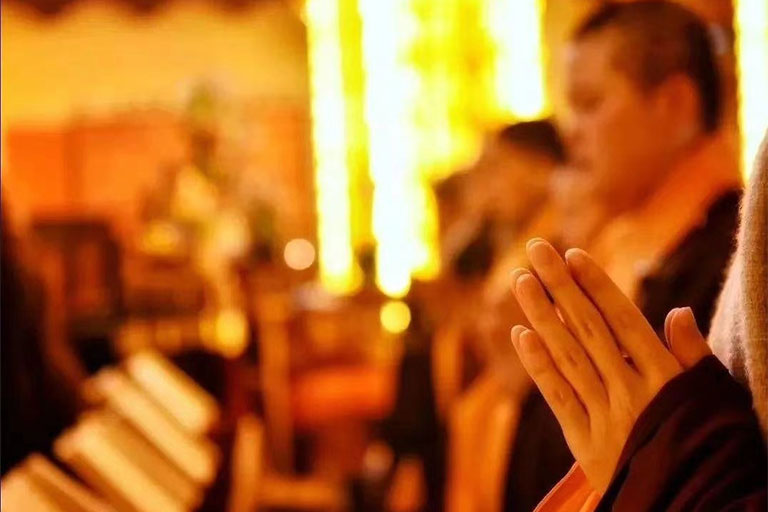 Pilgrimages in Mount Jiuhua
Pilgrimages in Mount Jiuhua
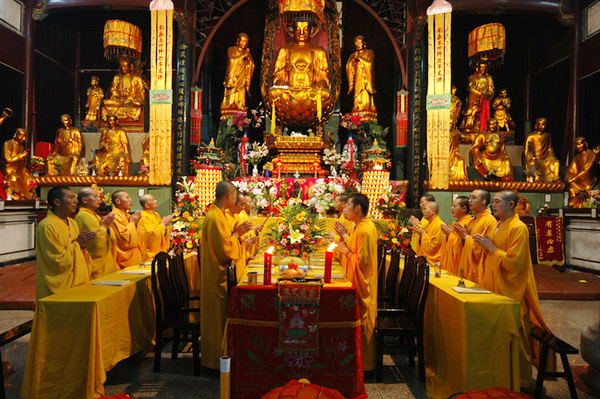 Jiuhua Temple Fair
Jiuhua Temple Fair
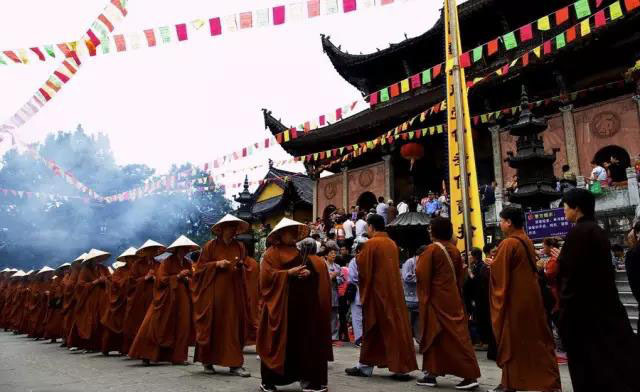 Land and Water Buddhist Ceremony
Land and Water Buddhist Ceremony
For hiking and trekking enthusiasts, Mount Jiuhua is also a nice destination. During your hiking trip, you can admire the nature, history and Buddhism as well. The hiking length can be arranged according to your travel time and physical condition. If you have only one day in Mount Jiuhua, we suggest you have a comfortable hike in Heavenly Terrace Scenic Area and Jiuhua Street Scenic Area and with full advantage of cable car. If you have two days, you can enjoy more natural scenery in Flower Terrace Scenic Area with cable car as well. If you want only hiking, you need to spend 2 days hiking in Heavenly Terrace Scenic Area and Jiuhua Street Scenic Area.
Travel Idea: For more wonderful hiking experience, don't miss Yellow Mountain, praised as the most picturesque mountain in China, and you will get more memorable hiking experience.
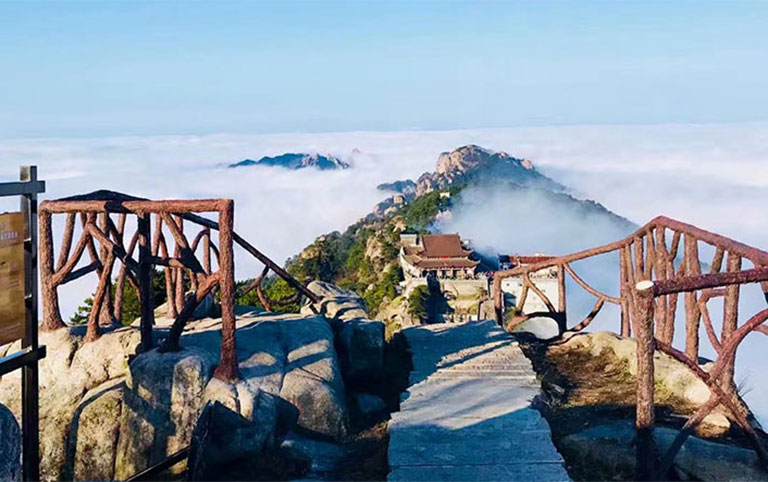 Hiking Road in Mount Jiuhua
Hiking Road in Mount Jiuhua
√ 2 Days Mount Jiuhua Scenic Hiking Tour
√ 3 Days Huangshan Classic Hiking Tour
√ 6 Days Shanghai, Mount Jiuhua & Huangshan Tour
It is recommended to spend 2 days exploring Mount Jiuhua to the fullest, both its nature and culture. On the first day, arrive at Jiuhua Street, visit Zhiyuan Temple, Huacheng Temple, walk (around 40 minutes) or take cable car up the Longevity Palace to see Yingshen Bodhisattva and Hall with 500 Arhat Statues, reach the viewing deck to catch the amazing sleeping Buddha. Walk or take cable car down to Jiuhua Street. Be followed your trip to The Incarnation Grand Hall. On the second day, walk (about 3 hours) or take cableway up to Tiantai Peak to visit Tiantai Peak and have panoramic view of Mount Jiuhua with many magnificent peaks, like Shiwang Peak, Lazhu Peak, etc. Get down the mountain by taking cableway and on the way, if you like, visit Ganlu Temple. After the Buddhism trip, you'll be escorted to Chizhou Airport or Chizhou Railway Station.
Mt. Jiuhuashan owns the feature of subtropical monsoon climate and alpine climate. It is moist and rains a lot on the mountain with an average rainfall of 2400 mm and an average temperature of 13.4℃. The weather changes very distinctly at a high elevation – spring comes late, summer is short, autumn comes early and winter is long.
In spring season, it is cloudy and foggy and travelers who reach the top of the mountain can enjoy the spectacular sea of clouds. Moreover, it is windy in May which lasts for about 20 days. During April to June, travelers can enjoy azalea, peach, Chinese rose, camellia, peony, Chinese herbaceous peony, like beautiful painting unfolding before your eyes. Summer is the best time to escape heat from bustling city and enjoy the cool of Mount Jiuhua which has an average temperature of 23.8℃. The autumn season in Mount Jiuhua has about only two months at Jiuhua Street and only one month at Tiantai Peak. In the middle of September, the whole mountain is turning into golden and red which makes it the best time to appreciate colorful leaves and flowers. From the middle of November to late March is the winter season with 36 days snow-capped days which could be the crystal palace over the mountain. Each season has its own features and the most recommended seasons are from the middle March to Middle November.
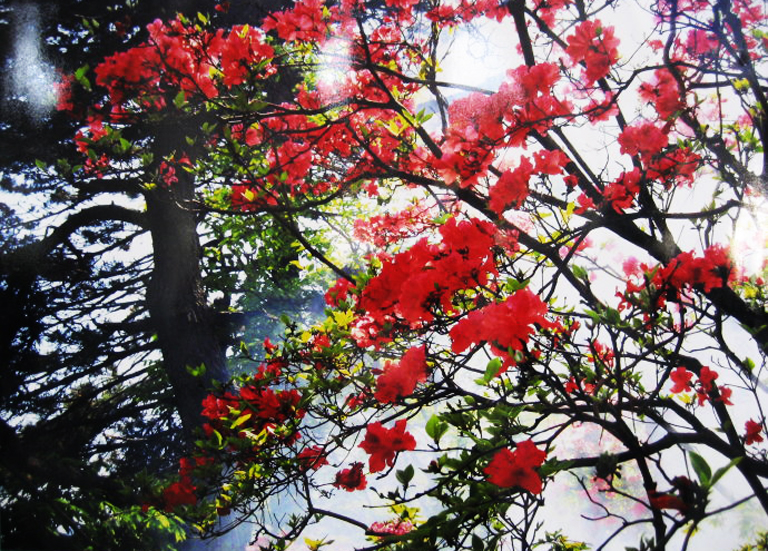 Visit Mount Jiuhua in Spring
Visit Mount Jiuhua in Spring
Mount Jiuhua is located in the southwest of Qingyang County, Chizhou City in Anhui Province, which borders Yangtze River in the northeast and Yellow Mountain in Huangshan City in the southeast, about 100 kilometers away. Travelers can take flights, trains and coaches to Chizhou City first and then transfer to Mount Jiuhua.
Chizhou Jiuhuashan Airport has flights from/to Beijing, Shanghai, Xian, Guangzhou, Chengdu, Xiamen, Hangzhou, Shenzhen, Kunming, Jinan, Dalian and Nanjing. There are airport shuttle buses running between Jiuhuashan Bus Station and the airport which takes around 40~50 minutes, and charges 20 Yuan per person.
Chizhou Railway Station is the main train station served in Chizhou and Mt. Jiuhuashan. Trains are available between Chizhou and Hefei, Shanghai, Hangzhou, Suzhou, Nanjing, Beijing, Wuxi, Wenzhou, Anqing, Ningbo, Nanchang, etc. While, the distance between Chizhou Railway Station and Mount Jiuhua is 48 kilometers which takes 1 hour for transfer by car.
Shanghai - Chizhou High Speed Trains: The distance between Shanghai and Chizhou is about 430 kilometers. Every day, there are 10 G trains running from Shanghai to Chizhou which takes about 3 hours and 40 minutes. The earliest one departs from Shanghai Railway Station at 06:02 and the last one departs from Shanghai Hongqiao Railway Station at 17:07.
Hefei - Chizhou High Speed Trains: The distance between Hefei and Chizhou is about 160 kilometers. Both D trains and G trains are available with 9 schedules daily. It runs from Hefei South Railway Station to Chizhou Railway Station and the earliest one is at 06:51 and the last one is at 20:07. It takes less than 1.5 hours from Hefei to Chizhou.
Travelers can take long distance buses to Chizhou Long-distance Bus Station from Huangshan Tunxi, Hefei, Shanghai, Hangzhou, Nanjing, Wuhan, etc. The distance between Huangshan City and Chizhou Long Distance Bus Station is about 185 kilometers. Usually, buses depart from Huangshan Tunxi at 08:30, 09:20, 13:10 and 14:40. It costs around 80 Yuan per person. (Please note: schedules and price may do some change based on the real situation. To buy long distance bus tickets, you'd better head to the corresponding station for detailed information and buy tickets in advance.)
The distance between Chizhou Long-distance Bus Station and Mount Jiuhua is 53 kilometers. You can take buses at Chizhou Long-distance Bus Station which are available at 07:00, 08:00, 10:00, 11:00. 13:00 and 14:00.
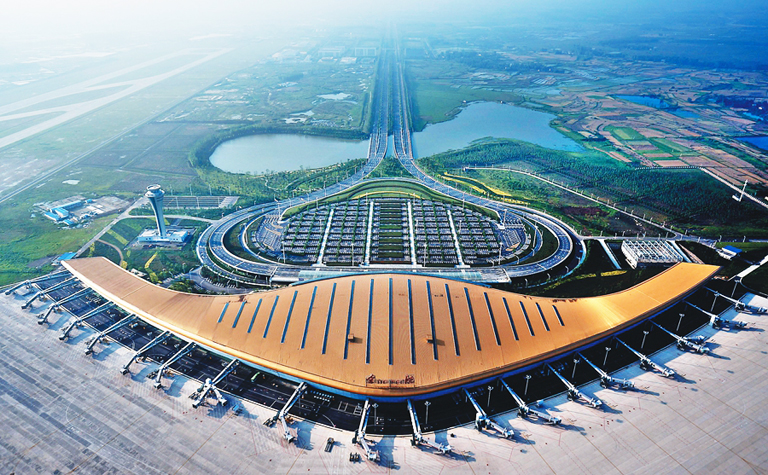 Chizhou Jiuhuashan Airport
Chizhou Jiuhuashan Airport
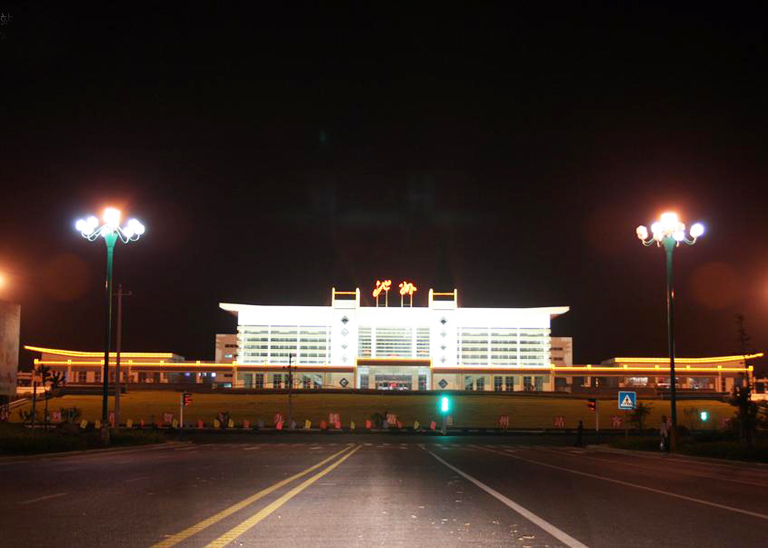 Chizhou Railway Station
Chizhou Railway Station
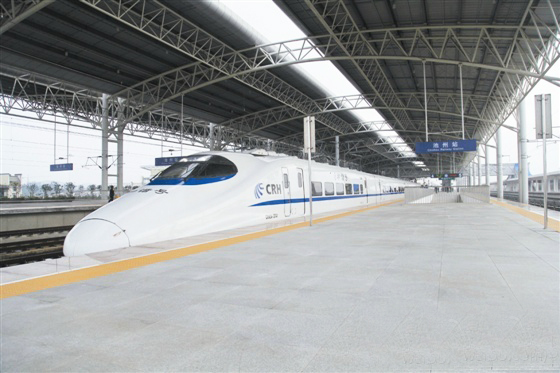 Chizhou High Speed Train
Chizhou High Speed Train
If you want to get rid of hustle of public transportation and troublesome navigation, you can take a private tour package which covers sightseeing, dining and transfer from us. Our local tour guide and driver will escort you to Mount Jiuhua with speed and convenience, and take care of all the details. You just need to focus on sightseeing.
Travelers can take sightseeing bus to travel around Mount Jiuhua. It charges 50 Yuan per person to reach Jiuhua Street, Ganlu Temple, Minyuan Garden, Zhiyuan Temple, Huacheng Temple, etc.
Besides, there are three cableways in Mount Jiuhua helping you get up and down - Baisuigong (Longevity Palace) cable car, Tiantai (Heavenly Terrace) Cable car and Huatai (Flower Terrace) cable car.
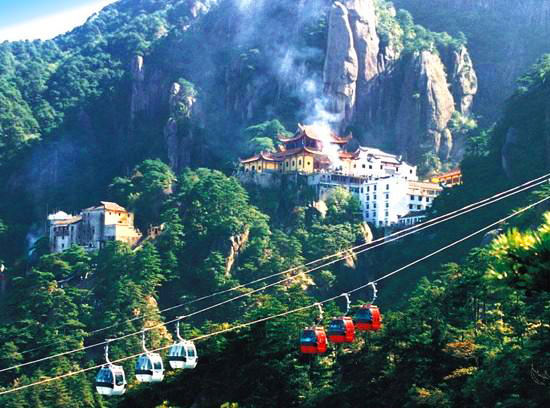 Mount Jiuhua Cableway
Mount Jiuhua Cableway
When traveling in the holy Buddhist mountain, you are guaranteed a comfortable stay. Choices are many - you can choose from the 5 star luxury hotels, 4 star hotels to cheap hotels and hostels. The most recommended ones are Jiuhuashan Julong Hotel (4 star) and Jiuhuashan Dongya Hotel (4 star).
Jiuhuashan Julong Hotel: It is located at No.2 Huacheng Road, Jiuhua Street of Mount Jiuhua Scenic Area, close to Zhiyuan Temple. Opened in 2011, Jiushan Julong Hotel has modern facilities, including 232 rooms, 3 meeting rooms, Chinese & Western cuisines, Sauna, Gym, bar, free Wifi, entertainment facilities, etc. It is a good choice for travelers to stay in an advanced hotel well blended with nature.
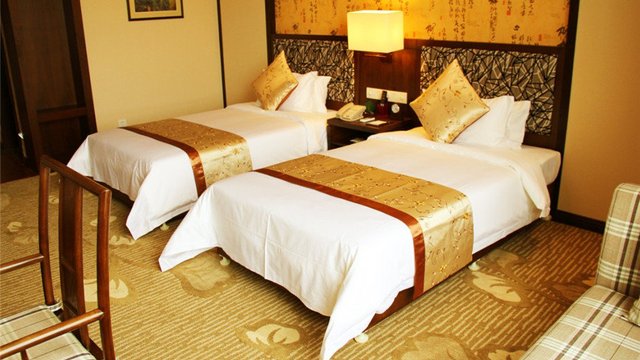 Jiuhuashan Julong Hotel
Jiuhuashan Julong Hotel
Jiuhuashan Dongya Hotel: This 4-star hotel located No.8 Huachang Road, Jiuhua Street of Mount Jiuhua Scenic Area, close to Huacheng Temple. There are altogether 240 rooms with several types, including business standard rooms, executive standard rooms, deluxe standard rooms, business suite, family triple rooms, business single rooms, deluxe single rooms. In the convenient Dongya Hotel, you can have an enjoyable accommodation, experience good service.
With strict rules no matter the monks or the local resides and travelers, they are forbidden to eat meat but vegetarian food. Hence, the vegetarian food in Mount Jiuhua is famous. You can taste fresh bamboo shoots, sealwort, agaric, been seeding, fiddlehead, etc. The dishes are fragrant, brittle, fresh and tender. You can enjoy the food at the temples or local restaurants at Jiuhua Street.
How to Get to Mount Jiuhua: Take a flight to Chizhou Jiuhuashan Airport or take a high speed train to Chizhou Railway Station from Beijing, Shanghai…; Drive about 2 hours from Huangshan.
Best Time to Visit Jinan: Mid-March to Mid-November, because the temperature is comfortable with the best scenery; many Buddhist festivals and ceremonies are held.
Top Places to Visit on Mount Jiuhua: 99-Meter Ksitigarbha Bodhisattva, Longevity Palace, Huangcheng Temple, Tiantai Peak, Tiantai Temple…
No matter you’re a Buddhist follower or sightseeing tourist, 2 days is most suitable for a Mount Jiuhua tour. Detailed attractions and tour order can be flexibly arranged based on personal interest, time and energy.
If you specially visit Mount Jiuhua for Buddhist pilgrimage, then Buddhist temples are the must-visits. On your arrival day, you can visit the 99-Meter Golden Statue of Ksitigarbha Bodhisattva at the north foothill. In and around Jiuhua Street, you can visit Huangcheng Temple - the first Buddhism temple of Mount Jiuhua, Incarnation Grand Hall which enshrines the flesh body of Ksitigarbha Bodhisattva, Zhantanlin Temple with massive delicate carved architectures and Zhiyuan Temple - the largest temple with the most complete layout, etc. On the second day, you can get to Longevity Palace to worship the incarnation of famous Chinese monk Haiyu (Wuxia) and Heavenly Terrace Peak (Tiantai Peak) where the highest temple - Tiantai Temple lies.
✔ 2 Days Mount Jiuhua Buddhism Tour
If you’re also a traveler fascinated by natures and physical condition permits, then you can view charming mountain landscape in the Flower Terrace Scenic Area with a special Hanging Plank Road hiking experience.
✔ 2 Days Mount Jiuhua Scenic Hiking Tour
✔ 4 Days Mount Jiuhua Buddhism Tour with Shanghai Essence
After your Mount Jiuhua tour, Mount Huangshan, just 2 hours’ ride away, is a popular UNESCO World Cultural & Natural Heritage worth your exploration with another 2 days. Chinese ancient culture buffs also like to visit Hongcun, Xidi and other ancient Huizhou-style village around the Mount Huangshan. If time allows, you may extend trip further to Wuyuan and Jingdezhen in neighboring Jiangxi, Mount Putuo and other famous Buddhist mountains and many more major tourist destinations in China.
✔ 5 Days Huangshan Tour & Buddhist Pilgrimage to Mount Jiuhua
✔ 5 Days Buddhism Tour to Mount Putuo & Mount Jiuhua from Shanghai
✔ 6 Days Shanghai Mount Jiuhua & Huangshan Tour
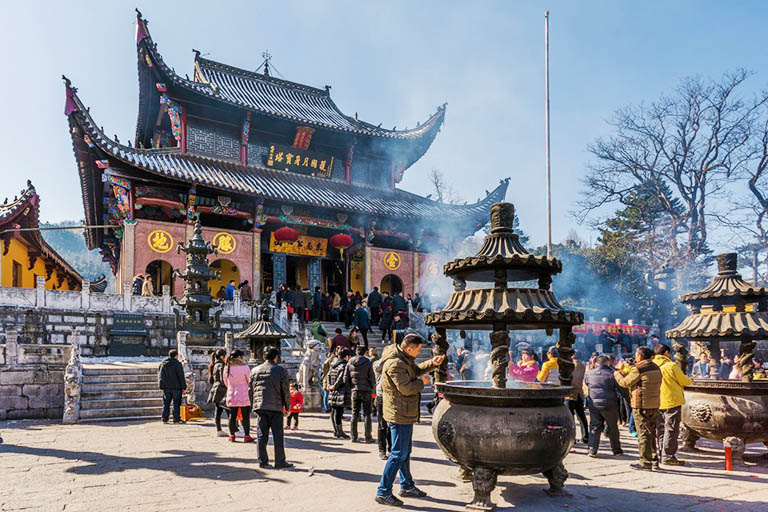 Pilgrims in Incarnation Grand Hall
Pilgrims in Incarnation Grand Hall
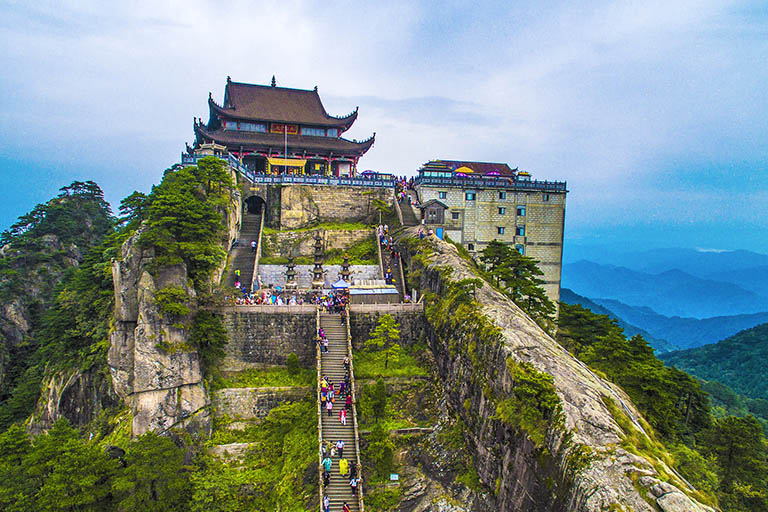 Tiantai Temple on Heavenly Terrace Peak
Tiantai Temple on Heavenly Terrace Peak
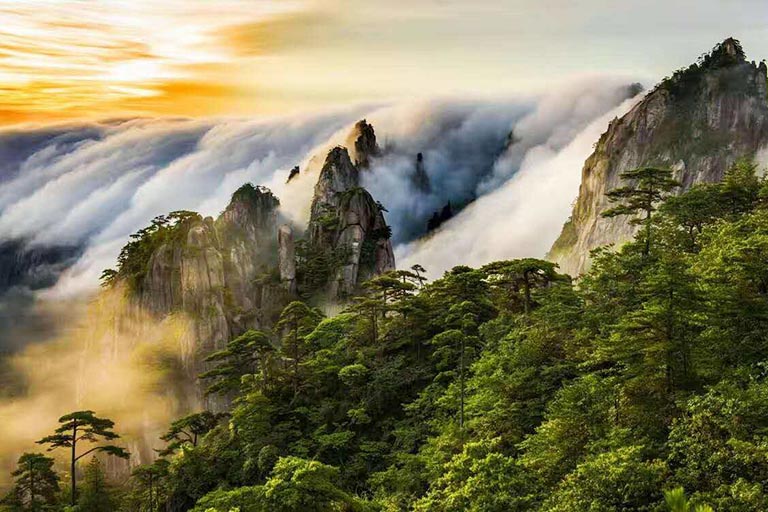 Dreamlike Scenery of Mount Huangshan
Dreamlike Scenery of Mount Huangshan
China Discovery is an experienced, professional and reliable travel companion devoted to offering high-quality and the best tour services for all travelers to China. In order to have a hassle-free travel and focus on the trip itself, it’s highly recommended travelling with China Discovery. So, you can enjoy convenient airport pick-up and drop-off service and transportation to all scenic spots in a safe, clean, comfortable, air-conditioned and non-smoking vehicle. Also, we will arrange knowledgeable local tour guide, excellent accommodation and dining arrangements to ensure you rest well and get better understanding of Buddhist of Mount Jiuhua. You may select a favorite from our most popular Mount Jiuhua tours or contact us to design a unique itinerary according to your personal time and preference.
Top 3 Mount Jiuhua tours chosen by most customers to explore Mount Jiuhua in the best way. Check the detailed itinerary, or tailor your own trip now with us.
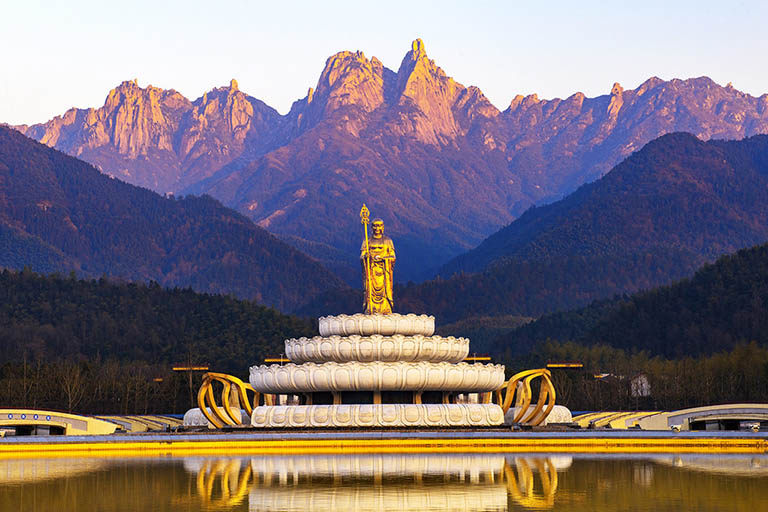
Mount Jiuhua
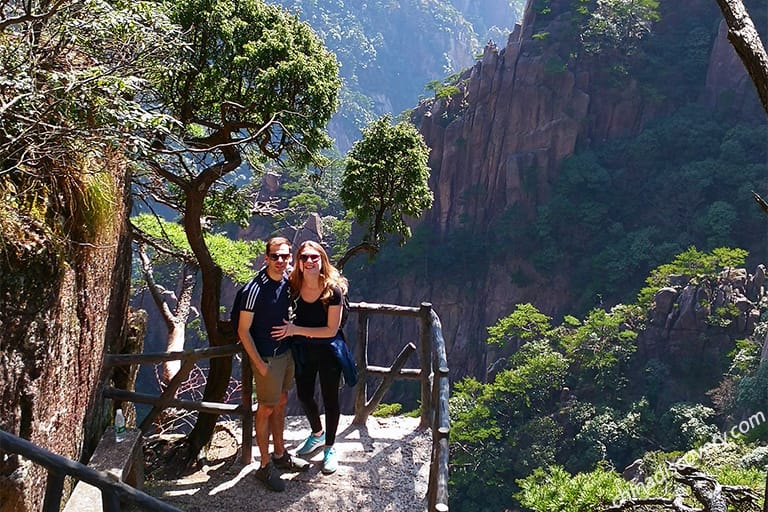
Shanghai / Jiuhuashan / Huangshan
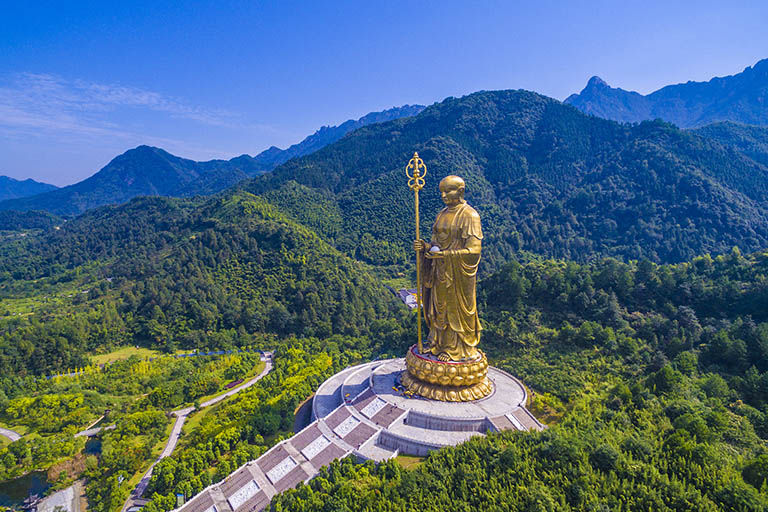
Shanghai / Mount Putuo / Mount Jiuhua
Start planning your tailor-made holiday to China by contacting one of our specialists. Once inquired, you’ll get a response within 0.5~23.5 hours.
Customize a TripFollowing are latest questions and answers from our webusers and customers. You can learn many useful information from the discussion and cases. You can also join in the discussions or ask your own question. Our experts will help you ASAP.